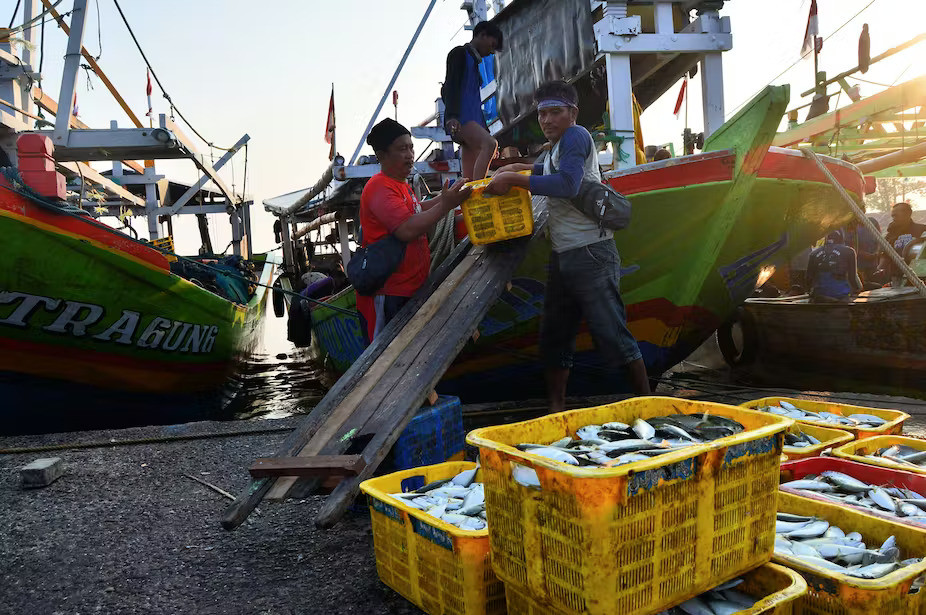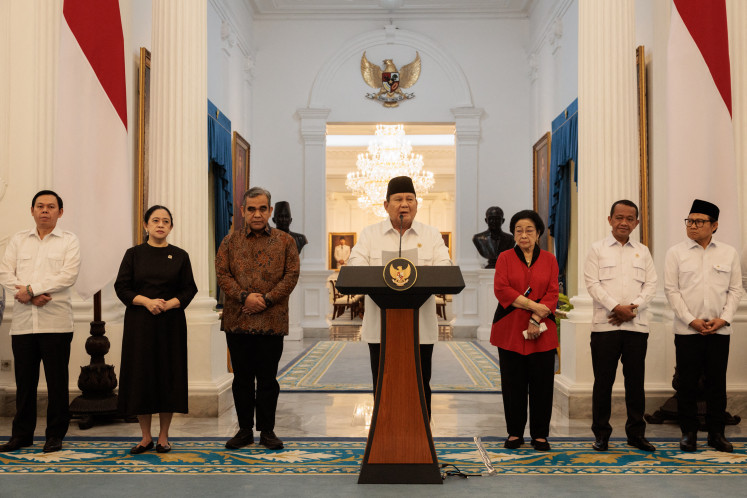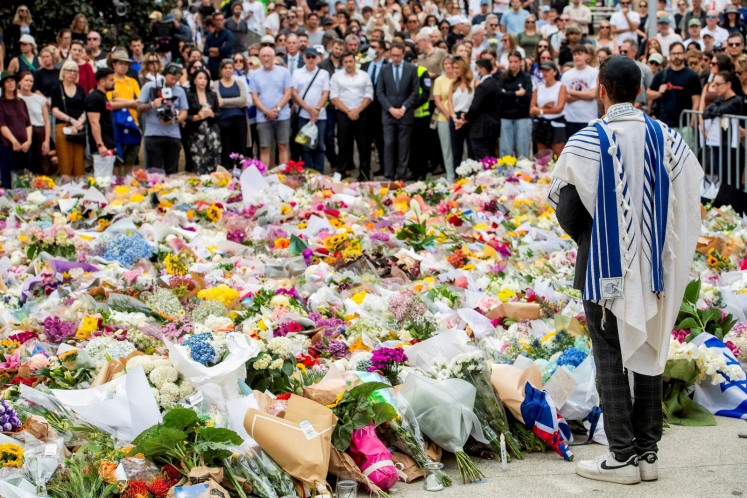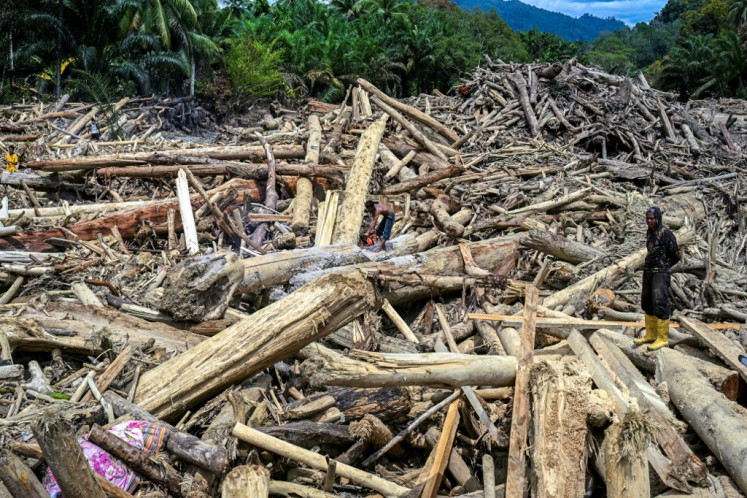Popular Reads
Top Results
Can't find what you're looking for?
View all search resultsPopular Reads
Top Results
Can't find what you're looking for?
View all search resultsBetter care for locals and the ocean to make Indonesia’s blue economy more viable
Small-scale fisheries are integral to sustaining food security and livelihood in Indonesia as the world's largest archipelagic nation.
Change text size
Gift Premium Articles
to Anyone
T
he world depends on the ocean to meet increasing demands for food, income, energy and minerals and transportation. However, marine ecosystems face serious challenges from over-exploitation, extraction, pollution, loss of biodiversity and climate change.
Now more than ever, there is an urgent need to strike a balance between production and protection for all ocean users’ current and future needs.
But as shown by our report, marine resource management in Indonesia – the world’s largest archipelagic nation and the richest in marine biodiversity – is complex.
Furthermore, Indonesia is preoccupied with wild capture fisheries, aquaculture production, and commodity supply chains for local and global seafood supply chains.
Meanwhile, local fishers with small boats have had little traction in Indonesia’s marine and fisheries governance, despite their important roles in ocean protection.
Displacement of small-scale fishers
Small-scale fisheries are integral to sustaining food security and livelihood in Indonesia.
Nearly 96% of fishing vessels in Indonesia are under ten gross tons. Yet only 20% of Indonesia’s fish catches come from small-scale fishers.
This has to do with the lack of recognition and support. There is continued marginalisation of small-scale fishers and their living space due to competition for space with corporations or large investments – such as the conflict in South Sulawesi between small-scale fishers and sand mining companies. The conflict deprived the fishers of living space by exclusively controlling the catchment zones and physically destroying the sea ecosystem and livelihood source.
Fisher households in Indonesia are still among the poorest of the poor. Statistics indicate fewer and fewer people are opting to stay in this sector.
However, government programs may also be a reason for the marginalisation of small-scale fishers. For example, quota-based fisheries policy, which aims to manage the fisheries sector by implementing a quota for the catches, has raised concerns of majority concession control by only several large-scale fishing industries and investments. This only leaves a small portion of the quota for traditional, artisanal, and small-scale fishers, while creating widening income gap.
Alienation of small-scale fishers reinforces an unbalanced distribution of ocean benefits and over-extractive behaviour in the economy, decreasing long-term ocean performance.
Poor quality control in export
Indonesia is the second-largest wild-capture fisheries and aquaculture producer after China. Despite its high production, the country is not a large-scale exporter. Its seafood exports were not among the world’s top ten in 2020 and are lower than those of Vietnam and Thailand, which produce smaller volumes.
In 2018, for example, the value of Indonesia’s exports was US$4.9 million, far lower than the US$9 million exported by Vietnam. These numbers are particularly striking given that Indonesia accounts for 8% of global fish production and Vietnam just 4%.
Indonesia’s fisheries sector has been unable to meet its production, export and growth targets since 2017, before the COVID-19 pandemic began. This lag in meeting export targets started even earlier in 2015. It is clear there is a management problem here.
Among the reasons is Indonesia’s low-quality products, which in turn generate low revenue. The country has one of the world’s highest rejection rates of fishery products. Products are often contaminated due to the low level of awareness of fishers and the fisheries sector in safeguarding quality. The problem is exacerbated by the lack of government and corporate control over using unsafe materials for preservation and processing.
Furthermore, Indonesia’s catch statistics are not aligned with its trade statistics. For example, Indonesia’s seaweed production seems impressive in volume, however its significance to export value is low. Indonesia exports Eucheuma cottonii seaweed carrageenan in raw form, meanwhile what is reported in production statistics is its volume when wet with high water content.
Poor management harms Indonesia's environment and economy
The future of the sector doesn’t look promising. The deterioration of fish stock, with poor management, compounds the potential fall of marine and fisheries sector’s economic performance.
Poor management comes in various forms. Illegal, unregulated and unreported fishing practices include foreign boats that are authorised to fish, but misreport the size or type of their vessel to avoid monitoring and taxes. These practices also includes foreign boats disguising their true ownership by using local names, or both local and foreign boats misreporting what they have caught.
Indonesia loses US$4 billion annually due to illegal, unregulated and unreported fishing, while global loss is estimated at around US$10-23 billion annually.
This type of fishing has resulted in about 75% of Indonesia’s fish resources being fully exploited or overfished. This is a significant burden to the 96% of Indonesia’s fishers that are small-scale and operating in increasing cost of production in overexploited waters.
Adequate data is required to maintain the long-term performance of capture fisheries. This includes stock status and fishing efforts, such as vessel capacity, hours or days spent fishing, and fishing gear used.
However, this also proves to be a problem. Capture fisheries in Indonesia use various gears and target multi-species, creating complexity in predicting the population dynamics of targeted species. Furthermore, vessel dynamics are also elusive, with difficulty tracking and monitoring Indonesia’s massive waters.
These issues highlight the need for bottom-up participation in creating rules and regulation.
3 ways to move forward
There are three ways on how we can involve and benefit more people in ocean management.
The first is to engage stakeholders, including small-scale fishers, in the marine resources and fisheries management decision-making.
Indonesia’s political dynamics influence decision-making around the management of marine resources and fisheries. For example, the government aims to increase the economic growth and investments through “blue economy” by, among others, implementing the quota-based fisheries policy that marginalises traditional, artisanal, and small-scale fishers.
Secondly, we need to improve analysis and data collection for effective and sustainable management.
Indonesia needs to overcome the disconnect between production numbers and export to monitor the sector’s economic performance and social and environmental performance. Collecting adequate data to monitor the stock status and fisheries efforts (such as vessel capacity, number of hours or days spent fishing, fishing gear used) to safeguard long-term performance is also essential.
Lastly, we need to implement inclusive and gender equity strategies to support and enable long-term recovery and resilience of fishing communities.
The participation of women fishers is largely unrecognised in policy-making, although women represent 42% of the workforce of the fisheries sector and 74% of the aquaculture workforce. These are significant actors in the sector and in individual fisher households.
Placing humans and ecosystems at the centre of decision-making is very important to balance various human needs and marine uses, as well as maintaining ocean health and its long-term productivity.
![]()











